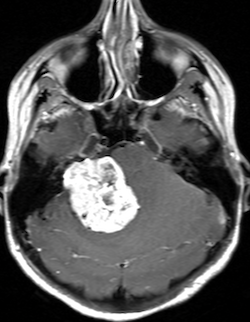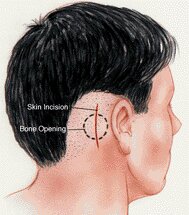Acoustic neuroma
Treatment of acoustic neuromas at UF Health Shands Hospital is provided by a multidisciplinary team of expert physicians, surgeons, physicists, therapists and support staff. Drs. Rahman, Chen and Antonelli perform the microsurgical treatment for these brain tumors. Drs. Friedman and Bova direct the stereotactic radiosurgical treatment. UF Health also provides comprehensive rehabilitative services for commonly associated symptoms, such as vertigo or dizziness, tinnitus (ringing in the ears) and facial muscle weakness.

Acoustic neuromas are non-malignant fibrous growths, usually originating from the balance nerve. Spread to other parts of the body is extremely rare. They constitute 6-10% of all brain tumors. Most of these growths are found in only one ear, but occasionally both ears may be affected. They’re located deep inside the skull and are adjacent to vital brain centers.
The common name, acoustic neuroma, is a misnomer as this tumor most commonly arises from vestibular nerve. Additionally, the tumor type is schwannoma, rather than a neuroma. Thus, the correct name is vestibular schwannoma.
Why Choose UF Health?
UF Health treats several vestibular schwannomas yearly and has a dedicated neurosurgical hospital with state-of-the-art operating rooms and specialized nursing staff. We take a multidisciplinary team approach to treatment, involving neurosurgery, neurotology (ENT), neuro-ophthalmology and radiation oncology. Patients will come together with a neurosurgeon and neurotologist to discuss and review all treatment options so they can make an informed decision with their physicians and family.
Expedited appointments with neurosurgery and neurotology are also offered, in addition to same-day appointments for hearing tests and expedited balance evaluations. We also have same-day appointments available for high-resolution imaging and neurosurgery evaluation.
Symptoms
The first signs or symptoms usually are related to ear function and include noise in the affected ear, hearing loss in one ear, and imbalance and vertigo. As the tumors enlarge, they involve other surrounding nerves, resulting in facial numbness, double vision or swallowing dysfunction. Headaches may develop as a result of increased pressure on the brain. If allowed to continue over a long period of time, this pressure on the brain may ultimately be fatal.

Diagnosis
Diagnosis is often confirmed with an MRI scan of the brain utilizing contract enhancement. The scan will allow evaluation of the exact tumor location, size and involvement with adjacent brain structures. Additional tests, to include a hearing or balance test, may be necessary for complete evaluation.
Treatment
Only rarely do vestibular schwannomas pose any immediate threat to life. Some of these tumors may remain dormant or grow slowly over many years, and some small tumors can be observed without treatment.
However, most VS should be treated, especially if there is documented evidence of growth or if the tumor is causing a significant neurological deficit, usually of hearing or facial function.

There are several operative approaches that can be taken to remove the tumor. The middle fossa approach is selected for very small tumors in patients with excellent hearing.
Another approach, the translabyrinthine approach — directed behind the ear through the mastoid to the area under the brain — is reserved for patients in whom there is no usable hearing. The third approach, called the retrosigmoid approach, is utilized for a variety of tumors with the potential to preserve hearing.
Over the past decade, radiosurgery has become increasingly popular. Radiosurgery is an outpatient procedure that starts with the attachment of a "head ring" under local anesthesia.
After detailed computer planning, hundreds of very small radiation beams are focused on the tumor. Long-term tumor control rates are high, and the risk is low.
Medical therapy using an intravenous medication called Avastin (Bevacizumab) is being used in patients with neurofibromatosis 2 (NF2).
In several small studies, this medication has been shown to improve hearing, reduce tumor size and buy time until open surgery is needed in certain patients.
